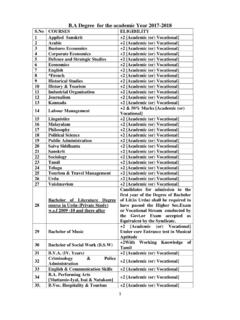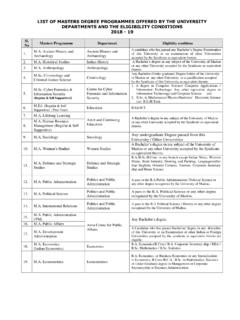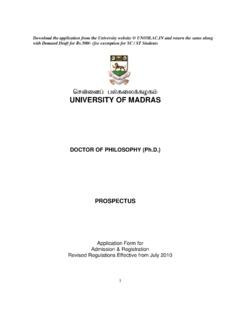Transcription of How to Change Your Mind - University of Madras
1 ALSO BY Michael PollanCookedFood RulesIn Defense of FoodThe omnivore s DilemmaThe Botany of DesireA Place of My OwnSecond NaturePENGUIN PRESSAn imprint of Penguin Random House LLC375 Hudson StreetNew York, New York 2018 by Michael PollanPenguin supports copyright. Copyright fuels creativity, encourages diverse voices, promotes free speech, and creates avibrant culture. Thank you for buying an authorized edition of this book and for complying with copyright laws by notreproducing, scanning, or distributing any part of it in any form without permission. You are supporting writers andallowing Penguin to continue to publish books for every here and here from Homological scaffolds of brain functional networks, by G.
2 Petri, P. Expert, F. Turkheimer, , D. Nutt, P. J. Hellyer, and F. Vaccarino, Journal of the Royal Society Interface, OF CONGRESS CATALOGING-IN-PUBLICATION DATAN ames: Pollan, Michael, 1955 : How to Change your mind : what the new science of psychedelics teaches us about consciousness, dying, addiction,depression, and transcendence / Michael : New York : Penguin Press, : LCCN 2018006190 (print) | LCCN 2018010396 (ebook) | ISBN 9780525558941 (ebook) | ISBN9781594204227 (hardback)Subjects: LCSH: Pollan, Michael, 1955 Mental health. | Hallucinogenic drugs Therapeutic use. | Psychotherapy patients Biography. | BISAC: BIOGRAPHY & AUTOBIOGRAPHY / Science & Technology.
3 | MEDICAL / Mental : LCC (ebook) | LCC .P65 2018 (print) | DDC dc23LC record available at : This book relates the author s investigative reporting on, and related self-experimentation with, psilocybinmushrooms, the drug lysergic acid diethylamide (or, as it is more commonly known, LSD), and the drug 5-methoxy-N,N-dimethyltryptamine (more commonly known as 5-MeO-DMT or The Toad). It is a criminal offense in the United Statesand in many other countries, punishable by imprisonment and/or fines, to manufacture, possess, or supply LSD,psilocybin mushrooms, and/or the drug 5-MeO-DMT, except in connection with government-sanctioned research.
4 Youshould therefore understand that this book is intended to convey the author s experiences and to provide an understandingof the background and current state of research into these substances. It is not intended to encourage you to break the lawand no attempt should be made to use these substances for any purpose except in a legally sanctioned clinical trial. Theauthor and the publisher expressly disclaim any liability, loss, or risk, personal or otherwise, that is incurred as aconsequence, directly or indirectly, of the contents of this names and locations have been changed in order to protect the author and my fatherThe soul should always stand ajar.
5 EMILY DICKINSONC ontentsAlso by Michael PollanTitle PageCopyrightDedicationEpigraphPrologue: A New DoorCHAPTER ONEA RenaissanceCHAPTER TWON atural History: BemushroomedCodaCHAPTER THREEH istory: The First WavePart I: The PromisePart II: The Crack-UpCodaCHAPTER FOURT ravelogue: Journeying UndergroundTrip One: LSDTrip Two: PsilocybinTrip Three: 5-MeO-DMT (or, The Toad)CHAPTER FIVEThe Neuroscience: Your Brain on PsychedelicsCHAPTER SIXThe Trip Treatment: Psychedelics in PsychotherapyOne: DyingTwo: AddictionThree: DepressionCoda: Going to Meet My Default Mode NetworkEpilogue: In Praise of Neural DiversityGlossaryAcknowledgmentsNotesBib liographyIndexAbout the AuthorPROLOGUEA New DoorMIDWAY THROUGH the twentieth century, two unusual new molecules,organic compounds with a striking family resemblance, exploded uponthe West.
6 In time, they would Change the course of social, political, andcultural history, as well as the personal histories of the millions of peoplewho would eventually introduce them to their brains. As it happened, thearrival of these disruptive chemistries coincided with another worldhistorical explosion that of the atomic bomb. There were people whocompared the two events and made much of the cosmic new energies had been loosed upon the world; thingswould never be quite the first of these molecules was an accidental invention of acid diethylamide, commonly known as LSD, was firstsynthesized by Albert Hofmann in 1938, shortly before physicists split anatom of uranium for the first time.
7 Hofmann, who worked for the Swisspharmaceutical firm Sandoz, had been looking for a drug to stimulatecirculation, not a psychoactive compound. It wasn t until five years laterwhen he accidentally ingested a minuscule quantity of the new chemicalthat he realized he had created something powerful, at once terrifyingand second molecule had been around for thousands of years, thoughno one in the developed world was aware of it. Produced not by a chemistbut by an inconspicuous little brown mushroom, this molecule, whichwould come to be known as psilocybin, had been used by the indigenouspeoples of Mexico and Central America for hundreds of years as asacrament.
8 Called teonan catl by the Aztecs, or flesh of the gods, themushroom was brutally suppressed by the Roman Catholic Church afterthe Spanish conquest and driven underground. In 1955, twelve years afterAlbert Hofmann s discovery of LSD, a Manhattan banker and amateurmycologist named R. Gordon Wasson sampled the magic mushroom inthe town of Huautla de Jim nez in the southern Mexican state of years later, he published a fifteen-page account of the mushroomsthat cause strange visions in Life magazine, marking the moment whennews of a new form of consciousness first reached the general public. (In1957, knowledge of LSD was mostly confined to the community ofresearchers and mental health professionals.)
9 People would not realizethe magnitude of what had happened for several more years, but historyin the West had impact of these two molecules is hard to overestimate. The adventof LSD can be linked to the revolution in brain science that begins in the1950s, when scientists discovered the role of neurotransmitters in thebrain. That quantities of LSD measured in micrograms could producesymptoms resembling psychosis inspired brain scientists to search for theneurochemical basis of mental disorders previously believed to bepsychological in origin. At the same time, psychedelics found their wayinto psychotherapy, where they were used to treat a variety of disorders,including alcoholism, anxiety, and depression.
10 For most of the 1950s andearly 1960s, many in the psychiatric establishment regarded LSD andpsilocybin as miracle arrival of these two compounds is also linked to the rise of thecounterculture during the 1960s and, perhaps especially, to its particulartone and style. For the first time in history, the young had a rite ofpassage all their own: the acid trip. Instead of folding the young into theadult world, as rites of passage have always done, this one landed them ina country of the mind few adults had any idea even existed. The effect onsociety was, to put it mildly, by the end of the 1960s, the social and political shock wavesunleashed by these molecules seemed to dissipate.










